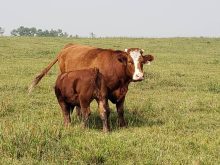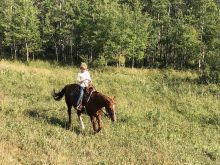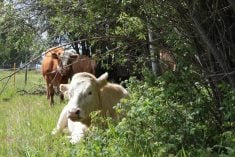On a scale of one to 10 do you know what your replacement heifers weigh?
It’s not a trick question, but if you’re interested in fine-tuning management to save about $60 per head and produce efficient replacement heifers, using a weigh scale is an important place to start, says an economist with the Western Beef Development Centre (WBDC).
Kathy Larson of the WBDC at Humboldt, Sask. says a three-year study showed replacement heifers that are about 10 per cent lighter than longtime industry guidelines at time of first breeding, perform just as well as those that are heavier. It is somewhat of a subtle difference but feeding heifers to have them at 55 per cent of their mother’s weight at time of breeding can trim about $57 per head from overall rearing costs. Not huge money, but when you consider the net cost of raising a heifer to first breeding age is between $1,100 and $1,200, saving a few dollars can’t hurt.
Read Also

Harvest wraps up and fall work begins
At the Eppich famly ranch in western Saskatchewan, the fall harvest was successful with few breakdowns, cows and calves have been sorted and a new tractor has arrived
“A general rule of thumb has been to aim to have replacement heifers weighing between 62 to 65 per cent of their mother’s weight at time of their first breeding,” says Larson. “But we found in our study if you target those heifers to achieve a more moderate rate of gain in the post-weaning period they perform just as well as those that had a higher rate of gain.”
And Larson’s work showed even with the slightly smaller heifers at first breeding, reproductive performance was still maintained three calvings down the road.
- Read more: AI study produced higher beef profits
While it adds cost, labour and management, Larson is a proponent of commercial beef producers weighing their cattle. It’s about “you can’t manage what you can’t measure.” There are some general management changes that may produce large benefits, but when it gets down to fine-tuning it is important to know weights of animals and manage for smaller incremental benefits. Larson has even developed a replacement heifer calculator found on their website at www.wbdc.sk.ca. If you know your numbers you can figure out the cost of raising a heifer on your farm.

The average mature cow weight at the WBDC is 1,410 pounds. In Larson’s research, the retained heifer calves averaged 558 lbs. at weaning. The moderate-gain heifers needed to gain 1.1 lbs. per day in order to reach 775 lbs. (55 per cent of 1,410 lbs.) by first breeding. The high-gain heifers needed to gain 1.5 lbs. per day in order to reach 874 lbs. (62 per cent of 1,410 lbs.).
The post-wean diet consisted of smooth bromegrass-alfalfa hay and rolled barley (free choice salt and mineral were also provided). Each weight group’s diet formulation was based on National Research Council requirements for growing heifers and the targeted rate of gain.
All heifers were placed on their respective post-wean diets in early November and were fed those diets for approximately 200 days until spring pasture turnout at the start of June. The feed and related development cost for the moderate gain heifers was $212 per head, while for the high-gain heifers it was $269 per head. Feed costs alone for the moderate-gain heifers were 28 per cent lower than for the high-gain group.
From pasture turnout onward, the heifers were managed together; first on mixed crested wheatgrass/smooth bromegrass pastures, then on barley greenfeed swaths (Nov. 1 to mid-Feb.) and then on grass-legume hay with range pellet supplementation (mid-Feb to May 30). The study followed them through to their third calving.
For more details on Larson’s study again visit the WBDC website.
















